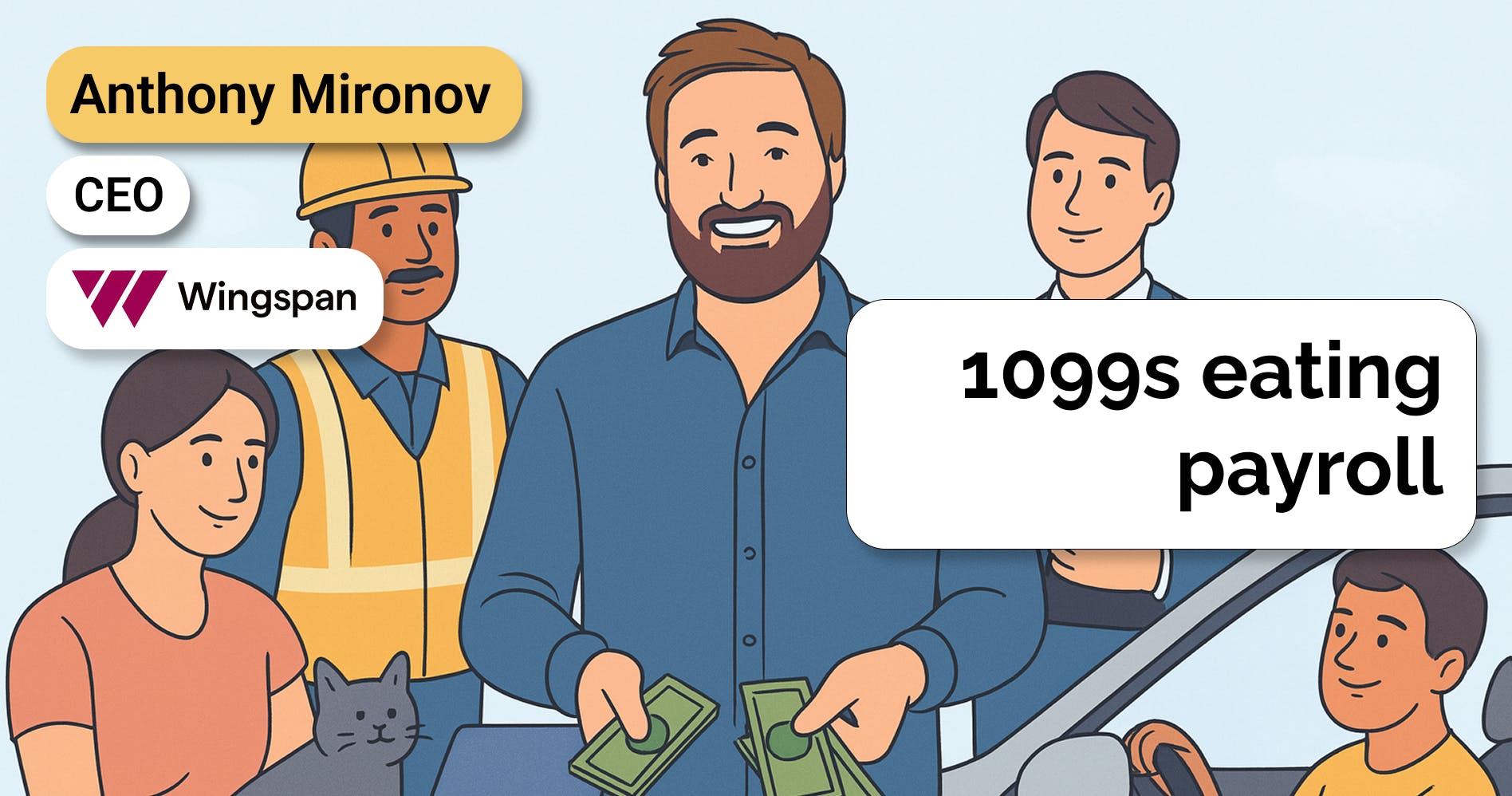Matt Brown, partner at Matrix Partners, on emerging trends in fintech and AI
 Jan-Erik Asplund
Jan-Erik Asplund

Background
Matt Brown is partner at Matrix Partners. We talked to Matt about the importance of embedded finance, particularly payments and lending, for vertical SaaS companies serving SMBs. We also talked about "ghost markets" and how AI will accelerate the need for a fusion of vertical software and fintech, ultimately changing the trajectory of company building.
Questions
- Can you tell us about the trends that stand out to you in the world you're focused on—fintech and fintech infrastructure? What are the businesses you’re really excited in betting on as you look at the future of ‘B2B payments’, both in terms of end-user vertical SaaS and in terms of the fintech infrastructure that enables it?
- The most common business model on the embedded finance side is obviously interchange. But what are the other standout forms of monetization that you're seeing companies build on top of Interchange?
- Do you see cards and card issuing as something that will be increasingly important or do you see check, cash, ACH as being quite durable in the B2B payments world?
- What do some companies and categories you're interested in as an investor or you think are indexed on this rise of embedded payments and vertical SaaS, look like? Two that come to mind are card issuing APIs and BaaS companies.
- How does AI become an accelerant to ambitious teams going multiproduct and eating up adjacent use cases? How does AI change the trajectory of company building?
- Could you just kind of explain your idea of ghost markets as well as your first-hand experience in dealing with one with your company Bonsai?
- You mentioned that the 1099 space is one of these “ghost markets” where it’s really a huge market of people that aren’t super well-defined. Would it be fair to say that in reality it’s a conglomeration of other markets that are potentially interesting if defined more narrowly? For example, companies like Wingspan are going after the segment of 1099 workers defined by large companies like medical staffing firms and insurance adjusters where companies will hire hundreds or thousands of contractors. Any other categories within that category that you can imagine?
- You mentioned that Keeper is going after 1099/freelance workers from the only angle that matters: the tax code. Can you speak more about that? Why did they pick the right wedge?
- Do you think most companies/customers in contractor payroll and related markets (in back office) want “one tool to rule them all,” whenever possible? If Rippling’s pitch is that they can do 100 things for you, even the most skeptical buyer might be amenable if it means you can save Dollars by not buying too many point solutions. Same, in a narrower sense, for a Gusto if you also use them for contractor payments, etc.
Interview
Can you tell us about the trends that stand out to you in the world you're focused on—fintech and fintech infrastructure? What are the businesses you’re really excited in betting on as you look at the future of ‘B2B payments’, both in terms of end-user vertical SaaS and in terms of the fintech infrastructure that enables it?
There's fintech generally, fintech infrastructure, and a lot of what I've spent time on also is fintech adjacent—vertical SaaS and embedded vertical SaaS companies monetizing through fintech. But they would consider themselves and their customers would consider them more vertical software than anything else.
In the last year, I wouldn’t say the strategy has changed dramatically. It's been more of this same kind of terminal trend, if you will, of companies seeing the value of verticalizing software, going down that path and realizing that while you're verticalizing software you're selling to SMBs, SMB SaaS can be a pretty tricky market. A lot of companies have recently figured out the economics and SMBs just have natural high structural churn, relatively low willingness to pay, relatively limited ability to upsell and expand your ACVs, and get to this natural net revenue retention that's close to or ideally above 100%.
I think a lot of those lessons, people already knew before this year, 2022. However, a greater number of SMBs going out of business and tightening their belts has made that abundantly clear. So, I think, that's highlighted the importance of embedded fintech and accelerated the adoption and the sophistication. What a given vertical SaaS company might've done in 18 or 24 months, they've kind of fast-tracked to do in 12 months or sooner. Part of that's driven by their underlying customers, as well.
If I'm an SMB and paying for 15 different subscriptions, and if one of my vendors comes to me and says, “Hey! Rather than paying 20 bucks for this scheduling tool and 50 bucks for your CRM and 75 bucks for your email marketing tool, we're going to give that all to you for one price, and it's all going to be together. And by the way, that includes payments and this other stuff,” I think, you’d see a lot of businesses making that choice as a way to cut costs and streamline things.
To summarize, I don't think the strategy has changed. I don't think we've seen any dramatically new models or anything like that. I just think that the value of number one, vertical SaaS bundling a bunch of software products together for a specific vertical, and then, number two, embedding financial products as a way to have a non SaaS revenue expansion path has continued to be proven there.
The most common business model on the embedded finance side is obviously interchange. But what are the other standout forms of monetization that you're seeing companies build on top of Interchange?
I guess there are two, I would say, payments. Then, within payments you can kind of break it down. When people say Interchange is typically about you issuing a card to somebody and then, they're spending with it, and then, the person who’s the card issuer gets a cut of that spread, that's one way.
I think that the faster way to revenue that a lot of companies are finding, is more around payments accepted. So I'm a vertical SaaS company that supports veterinarians and all of these veterinarians need to accept payments for their services we provide them, whether it's physical hardware and/or online invoicing. They pay the posted rate, which is, in the U.S., typically around 2.9%, 30 cents. Then, the idea is that by this vertical SaaS company having many, many, many veterinarians, they can get a discounted rate from their payment profit from Stripe or whoever it is, and they'll get charged.
I'm using very rough numbers here, but say they get charged 2.2% and then, they can pocket that 0.7% difference because their customers are paying 2.9%. That's probably the more common way that a lot of these companies start. Not every company or vertical needs to spend on cards or spends on cards enough to justify the cost of the program, but almost every company needs to accept payments and typically, needs to accept card payments in one form or another.
Do you see cards and card issuing as something that will be increasingly important or do you see check, cash, ACH as being quite durable in the B2B payments world?
Cards are only getting more important. How important they are, how much economics there is in there, and how interesting that is as a monetization channel will depend a lot based on the size of the customer. So painting with a very, very broad brush here, think of very small merchants, mid-sized merchants, and enterprise merchants, and you think about book B2B payments between or amongst them.
When you think about it—SMBs or very small merchants—and you can pick whatever arbitrary cutoff you want, but they typically don't have that much volume. They're price sensitive, and also not that sophisticated. These are the types of customers, types of merchants that will accept check. It's like your local services kind of business that’s like, “Hey! I would prefer you to mail me a check rather than me having to figure out this square terminal or for me to put up an invoice. Just give me a check, give me cash, here's my bank account information. Do transfer,” So, that kind of thing.
On the other side of the spectrum, the enterprise customers have a ton of volume. They're very sophisticated. They have whole teams of people dedicated to receiving payments and their cost of payments and all that stuff. So those enterprises, while they may be accepting cards, are probably not paying anywhere close to your 2.9% fees. Typically because they're so large, they can also just say, ”No. You're paying us through ACH. We're not paying any fees, and we don't care about that extra five or seven days that it takes for the payment to clear.”
So again, for a very different reason, I think the enterprise merchants, while they may accept cards and while there may be a role for cards in the workflows there, it's probably not just because of their size and ability to negotiate rates. It’s not an interesting segment to look at.
The mid-size merchants—and again, different ways of thinking of size here—could be anywhere from 50 to 1000 employees. That's kind of that sweet spot—the Goldilocks spot—where they're a large enough business that they have a lot of payment volume. They have some people—whether it's a finance person or an accounting person or an operations person—who thinks about and cares about the efficiency of the business. They don't want to deal with checks and reconciling all this stuff. They're probably investing in software and tools in some way but unlike enterprises, they're not so big that they can negotiate good rates and they really have the scale to control those economics.
Those mid-size merchants want to use cards and are very willing to do so, but are not big enough to really control their economics. That midsize is where I think you'll see a lot of the success in card issuing because they will spend a lot and the card spend will come with high margins.
What do some companies and categories you're interested in as an investor or you think are indexed on this rise of embedded payments and vertical SaaS, look like? Two that come to mind are card issuing APIs and BaaS companies.
One other category that's missing there—that's very important and which a lot of vertical SaaS companies will add pretty quickly after payments and often is as sticky and as profitable, if not stickier and more profitable than payments is—embedded lending. Of all the different embedded finance options, this is the one that, I think, has the greatest business model product fit.
There are all different kinds of SMBs. There are dog walking and pet grooming businesses, landscaping businesses, service businesses, and creative businesses all of which have different types of customers and different cash flow profiles. If you need some kind of business credit and you go to a bank, the bank will look at you as you are—a small business.
They'll look at a little bit more than that, but they'll kind of put you all in the same box and underwrite you in the same way. That's part of the reason why SMB credit has typically been tough in the past. It’s because the lenders are painting with a very, very broad brush and they're going to try to fit you into the same box.
The benefit with vertical SaaS companies is, because they're vertical, they can know an incredible amount about this very specific kind of business. So again, I'm just going to use this veterinarian example. If you are a vet company and you go to the bank, they're just going to look at your cash flow statement and your P and L—which they should since that's very important—but there's all this other stuff about your business—what do your bookings look like for the next couple months? How much of your business is recurring services versus one-time services? What's your relationship with or how much of your business comes from repeat customers or is paid out by some kind of insurance? How guaranteed is that insurance? What's the turnover on those payables?
By being a vertical SaaS company, you can know and underwrite businesses way better. Then, by knowing and underwriting them way better, you can offer credit products that are really specific to that business and can unlock growth. I think, the thing that's more important to that is, you can be proactive in offering that to them.
Again, if I am an veterinarian office and I bank with some bank, I have to go to that bank typically and say, “Hey! I would like a line of credit to do X, or I'd like a loan to expand to new location.” If I'm a vertical SaaS company, I'm typically sitting on top of all of that business’ operational data. I can see their bookings and employee schedule. It varies by vertical but you can do interesting things like say, “Hey! It looks like your bookings have been full 100% for the last six months. Wouldn't it really help if you could hire a new person or open a new location?” Then, “We've also looked at all of your finances and pre-qualified you for this. Would this be an attractive offer to you?”
That’s a long-winded way of saying, I think, for a variety of reasons, payments is kind of table stakes. It's important, it's a great way to create stickiness. It's a great way to monetize, and it is the necessary first step. You typically can't do lending very well unless you're sitting in the flow of funds. It’s the same thing with issuing, same thing with banking. You want a way to fund that account, but once you get payments, I think, lending is one of the things that SMBs are typically most starved for, most taken advantage of by traditional financial institutions.
Embedded lending not only makes it more accessible, but can make it cheaper because, again, as the vertical SaaS platform, you can underwrite these businesses better. You sit in the flow of funds so there's lower risk and you can increase your chances of recovering funds. There are all kinds of things that make it a much more attractive product distributed through vertical SaaS companies.
How does AI become an accelerant to ambitious teams going multiproduct and eating up adjacent use cases? How does AI change the trajectory of company building?
I've thought about this a lot. I have a slightly different take, which is I think that AI will accelerate the need for this fusion of vertical software in fintech. The reason for that is, if you look at the cost of building software over especially last decade, even the last two or three decades, I think, it's only gone down from being on-premise to the cloud to all these different developer infrastructure and developer tools. There's been a significant increase in the number of software developers out there—low and no code tools. So you don't have to build everything yourself. You can prototype it.
If there are some ways, and I've been looking for a while for what's the cost of a line of code written over time, I think, that's just been going down, down, down, and down.
To say AI is going to be the final nail in the coffin is probably a little too dramatic but if I wanted to build a highly customized CRM for myself, I could go do that with a low-code, no-code tool today. I can go build the database in Notion and then, plug that into Zapier and do this and, without actually writing a line of code, have something that pretty well fits this very bespoke workflow that I have.
That's going to be taken to a whole other level with AI where again, a lot of infrastructure needs to be built for this, but I can envision a world where a veterinarian goes to Chat GPT or some other service that says, “I'm a veterinarian. Let me describe my business to you. Here's what’s particular about my business. Maybe we also have an associated pet grooming business and we want to share customers between the two. Some of our customers are in person and some we go to them and some of this and some of that.”
I describe this very bespoke nature of my business. I can have built all of these different tools for me that are very specific to my own workflow. So I think that the cost of building highly, highly, highly personalized software is going to basically go to zero and it's going to go from these no code agencies that help do it to, again, a veterinarian who can describe this process and have something built in real-time for them. That's all to say, I think, the defensibility and stickiness of just pure vertical software companies is going to go down.
The way to defend against that if you're a vertical SaaS company is, what are the things that are going to be harder for a pure software Chat GPT written kind of product to do? A lot of that has to do with financial services—plugging in payments, plugging in lending, plugging in banking, and things like that. Even in those cases, there will be a big role for AI in developing those products, helping vertical SaaS companies build out the suite of products faster, for sure. But I think a lot of SaaS—and this isn't just applied to vertical SaaS—is going to have to find new ways of building and protecting value when it becomes just cheaper and cheaper and cheaper to build any software product that is highly specific to you.
You kind of go back to the classic business model thing of “where” is what creates value. That can be network effects. It's like, “Great. I can get Chat GPT to build me a clone of Facebook” but Facebook isn't that interesting to me unless all my other friends and family are on it. That's one thing.
Unique and bespoke, or unique data is another one. I can get Chat GPT to build me a copycat of Glassdoor, for example. But it's not that interesting without all of the salary data and reviews and things like that.
So, it's when the cost of one part of a business goes down dramatically, it puts the focus on what are the other non-commoditized or non-commoditizable things that remain. That's where, I think, a lot of the value will be created and/or defended.
Could you just kind of explain your idea of ghost markets as well as your first-hand experience in dealing with one with your company Bonsai?
Just to define ghost markets really quickly, there's this chart in the piece that talks about that. You can either be a horizontal solution, which is more focused on the “What”.
A Calendly, for example, is a classic horizontal solution where it's like the “what” that they solve is scheduling, and they solve that for salespeople. They solve that for small businesses, they solve that for entrepreneurs. It's the “what” that’s the constant thing. Then, there are a bunch of different “who's”.
Then, whereas vertical software is one where you kind of hold the “who” and a bunch of different “what's”. Vertical software is focused on, if we go back to this veterinarian case, you focus on veterinarians, then you solve scheduling, but you also solve payments and CRM, and you solve payroll and all these sorts of different things.
One of the things I don't like about the phrase vertical software is even though it is vertical software, it's not 100% vertical. Yes, the most important thing is who you serve, but there's some aspect of what you have to solve, the scheduling and then this and that.
A ghost market is where you define the market relatively so extremely that it's almost like 100% defined as the vertical or 100% defined as the horizontal. So again, a contractor’s 1099 is one of those where it's just like, “Oh yes! There is this.” The reason why it's a ghost market is the very 100% vertically or 100% horizontally market completely exists. There is absolutely such a thing as 1099 workers and contractors and things like that. However, the problem is they're not this monolithic kind of block. Just like, yes, there is this problem of scheduling and getting things into a calendar in the horizontal market, but that's not this monolithic problem that is the same for everyone.
A lot of people will look at some big report or some big trend, and you should always be looking to think about finding new businesses, looking at trends and things like that. But they'll look at a trend like—25% of the US workforce is now 1099—and focus exclusively on that rather than trying to decompose that one or two more levels to say, “Within 1099, what are the segments? What are the problems that those segments are actually facing? What solutions can I offer to those segments?”
You mentioned that the 1099 space is one of these “ghost markets” where it’s really a huge market of people that aren’t super well-defined. Would it be fair to say that in reality it’s a conglomeration of other markets that are potentially interesting if defined more narrowly? For example, companies like Wingspan are going after the segment of 1099 workers defined by large companies like medical staffing firms and insurance adjusters where companies will hire hundreds or thousands of contractors. Any other categories within that category that you can imagine?
The litmus test for whether it's a ghost market or not, is if you go to very different people and you ask them, “If I were to ask you to describe your business or yourself, is the way that you, as the founder, describe them in one of the top three things that they say?”
As an example, if you say, “Oh! The 1099 freelancer contractor market is big.” Then, you go to a freelance designer and you say, “Hey! How would you describe yourself and your business?” They probably are not going to say 1099 anywhere in the first couple sentences. They're like, “Oh! I'm a designer. I'm an entrepreneur. I moonlight….” But they're not going to say 1099. That's not a tangible part of how they think about themselves. You go talk to, again, somebody very different, talk to an Uber driver. Say, “How would you describe yourself?” Again, I would be surprised if 1099 comes up anywhere in there.
Now the one counter example to that is there are some aspects that may cut across all of that. So where is 1099 actually important?
It's important in where it gets its name from in the tax code. All of these people, although they have different ways of thinking about their business and different ways of finding work and training and thinking about their career paths, the one thing that they literally all have in common is, every single year they get a 1099 tax form and they need to file this type of taxes.
That is one part of the 1099 market that is totally valid and that a lot of QuickBooks or whatever it is, don't serve well. There's a lot about taxes that is very specific to these folks. That's one thing where you could build this almost horizontal or horizontal-like solution. But yeah, trying to build something that's too all-encompassing for this market is probably going to miss the market.
You mentioned that Keeper is going after 1099/freelance workers from the only angle that matters: the tax code. Can you speak more about that? Why did they pick the right wedge?
I can't speak too much to Keeper's case, but I can say if you look at their site, they went from finding deductions for 1099 workers, which again is something that's very specific for the 1099 portion of the tax code. There are certain things that are tax-deductible and then, based on the work that you do, certain things are not tax-deductible. That's where they started. It looks like they've gotten into expense tracking, tax filing, and all this. They have expanded for sure, added other products and services, but it's very much around this tax use case.
Again, that's smart because who is using this? It's the freelancer, the graphic designer freelancer, and it's the Uber driver. Both of them need to file 1099 taxes. Both of them want to look up deductions. Both of them need to talk to a tax professional, but that's the right direction. It's kind of down in the process where they have commonalities, but if you start going up in their workflows, the commonalities all kind of fall apart. So again, I can't speak super authoritatively to the Keeper strategy, but it looks like they've expanded in the right direction.
Do you think most companies/customers in contractor payroll and related markets (in back office) want “one tool to rule them all,” whenever possible? If Rippling’s pitch is that they can do 100 things for you, even the most skeptical buyer might be amenable if it means you can save Dollars by not buying too many point solutions. Same, in a narrower sense, for a Gusto if you also use them for contractor payments, etc.
I think they can all be big, or I think each of those categories will be big independent categories because there's a slightly different kind of job to be done in each of those. All of them will have some kind of robust U.S. domestic payroll as well as some kind of employer of record/international contractor payroll component, as well as bundling services around time-off and benefits etc. They'll all have that but again, I think, there's enough difference in the ICPs that these categories will coexist.
There are some companies which might have a very small U.S. presence, but a very large international full-time contractor presence. I think of those as the deal models where it's like their strength is in being an international employer of record, but they also need some kind of strong domestic payroll component.
The reverse is you have something like a Gusto, and I imagine the ICP for them is companies that have primarily a U.S. domestic full-time employee component, and then, maybe some contractors or folks internationally. But the focus is on robust U.S. payroll. Then, while I'm not as familiar with Wingspan, I know there are companies that support this international mass payout contractor kind of thing, where it's like whether it's a company like Scale who has a bunch of folks internationally that are doing kind of micro work to label AI or translators or agencies or whatever that are doing this kind of mass payout, that's a very different kind of shape of business.
So yeah, I think they'll all compete with each other and all on the surface will end up looking somewhat similar. But again, depending on whether as a business, as a buyer of the software, where will most of the employees be? Is it domestic? Is it international? Are these full-time people that you expect to work on almost like an employee basis for a very long time? Is it more transactional work where you're kind project based? I think that will determine which of these will be the best fit.
Disclaimers
This transcript is for information purposes only and does not constitute advice of any type or trade recommendation and should not form the basis of any investment decision. Sacra accepts no liability for the transcript or for any errors, omissions or inaccuracies in respect of it. The views of the experts expressed in the transcript are those of the experts and they are not endorsed by, nor do they represent the opinion of Sacra. Sacra reserves all copyright, intellectual property rights in the transcript. Any modification, copying, displaying, distributing, transmitting, publishing, licensing, creating derivative works from, or selling any transcript is strictly prohibited.











